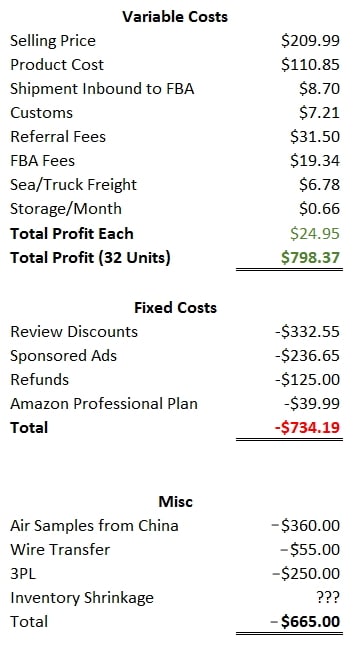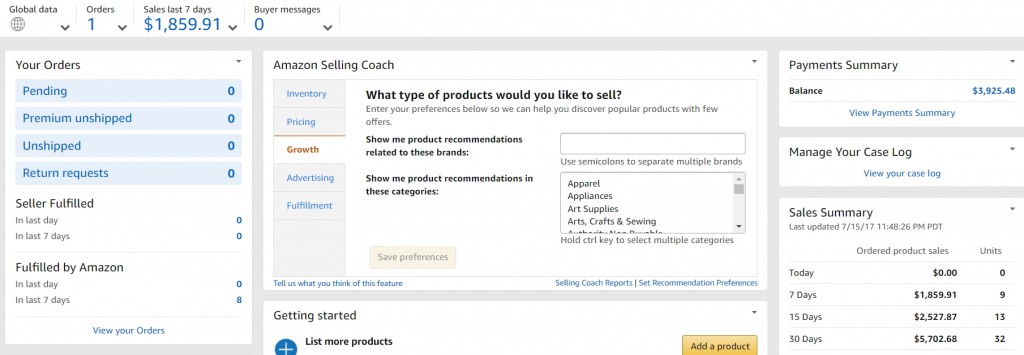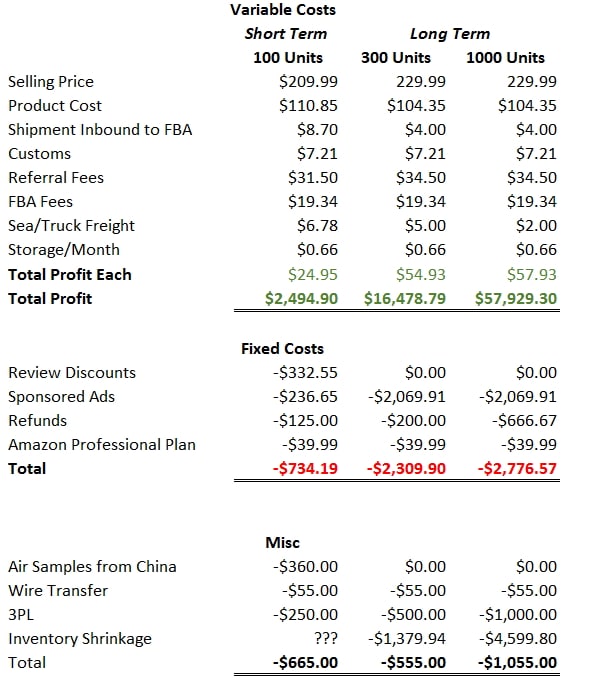PART 3: Rebuilding a $1M Ecommerce Business – First 60 Day Results
In the final part of this series of rebuilding a million dollar ecommerce business I am going to discuss my results after 60 days of selling. I am going to give a breakdown of the full revenue numbers including the all important profit numbers.
First Month Results – The Revenue
I received my first shipment of products on June 2 to my third party logistics company (3PL). It was around June 15 by the time Amazon finally received stock at their FBA warehouse. For the sake of this article I am considering the first month as June 15-July 15.
Over these 30 days Amazon has had $5702.68 in sales over 29 orders. These items have an average price of $199-209.
Additionally, I had 3 sales from eBay for $614.97. In total this is $6932.62 in 30 days for 32 product sales.
Amazon: $5702.68
eBay: $614.97
———-
Total $6,317.65
First Month Results – The Profit
Here's the part many Amazon/Private Label websites don't talk about – the profit. Either these people are explicitly hiding their profits because their profits are low or they don't really track their profit because they have bad accounting and book keeping. My experience is that small businesses almost always over-estimate profit as they forget or miss expenses. Even with my numbers below it's a not true representation of my actual corporate income as not all expenses are shown (things like various SaaS products and certain fixed expenses like cell phones, internet, etc.).

As you can see from above, for my first products I am making approximately $24.95 in profit. $24.95 is a small number percentage wise (a 12.5% profit margin) but a large actual dollar figure -no one selling a $20 widget can make $24.95 profit. It's better to sell one $200 product a day at 12.5% margin then fifty $1 items at a 30% margin.
Now here's the sad part. Once you start adding in other non-variable expenses like advertising/marketing, freight, and other miscellaneous business expenses the story is much less rosy. Here is an elaboration on some of these costs.
Review Discounts: I will have a separate post at a later date strictly about review strategies. These were discounts from selling products at a discounted price in hopes these people would leave reviews.
Read more: How to Get Amazon Reviews
Sponsored Ads: Right now our Sponsored Ads are running at about 12% ACoS (I have this listed as a fixed cost which isn't entirely accurate but sufficient for the sake of this post). I think long term this can get below 8%.
Refunds: I am absolutely vigilant in handing out customer refunds if there is any possibility of a negative experience. I handed out two $50 refunds for late shipments (before the items were received by FBA and we were seller fulfilled) and one $25 refund for some UPS damage.
3PL: This is the cost for our 3PL to receive the our shipment from China, label it, and send it to Amazon.
Inventory Shrinkage: Probably the most overlooked cost by ecommerce store owners. This is the amount of product lost, defective, stolen, etc. Typically around 1-2%.
So you can see that right now I've lost more than $700. After I sell through my entire 100 units I may make $1000 if I'm lucky. Chances are good that I will barely make closer to $500 in profit after taking into account shrinkage and advertising.
Long Term Sustainable Ordering Quantity
I am prepared to take a small profit, or even small loss, on my first order because I am aware of my long term sustainable ordering quantity.
I know that by ordering 300 units, instead of 100, I can drop my costs by just under $10. Whenever I am negotiating with Suppliers for the first time, I always ask them for their MOQ price and then ask what the price break is for larger orders. This Supplier offered a $6.50 price break if we ordered 300 units instead of 100. Ordering 300 units instead of 100 units will be my ultimate goal.
Also, by ordering more units I will save significantly on sea/truck freight. For 300 units I am still shipping LCL Sea Freight which doesn't have nearly as much savings as shipping a full container, but there are still some savings. On my first order to FBA, we also shipped everything in via UPS opposed to on pallets which would have dropped my inbound FBA costs by at least half.
Finally, I purposely priced our items well below their real value. The next closest competitor is around $270 (and I have bundled this item with another item making it so it can't be directly compared with another item). If I price our products at $229.99 instead of $209.99 I'll still be the least expensive.
The Importing Costs Optimization Curve
When you're importing from China there's one thing you want to keep in mind: what I call the Importing Costs Optimization Curve.
I'm trying to make myself sound way more academic than I really am, but basically the thing to know that as your orders get bigger there are economies of scale and your costs decrease. You should get lower prices from your Suppliers but you will also save significantly in freight costs. More or less, importing a 40′ container of products will achieve your absolute most optimal shipping costs – there's nothing bigger than a 40′ Container (to be exact, a 40′ HQ Container). There are HUGE savings when you move from air shipping to LCL sea shipping. And there are huge (no underline or capitals) savings between LCL sea freight (less than a container load) and 20′ FCL sea freight (full 20′ container freight) and big savings between a 20′ container and a 40′ container .
Your goal as an importer needs to be to eventually get to full container shipping. This means you've achieved full costs optimization so your competition can't easily undercut you. There are a few hacks we get to into our course into how to achieve this without importing 100,000 yoga balls but whether or not you purchase our course just know that you should always be working your way down the shipping costs optimization curve.
Second Month Results
During my second month of selling I pursued several avenues of expansion:
- I received 8 new products into stock (2 products have 3 variations each)
- I sent in my first batch of products to Amazon.ca
- I launched an Adwords campaign (taking advantage of the free $50 they give new accounts)
The results were as follows:
Amazon.com: $10,788.50
Amazon.ca: $1180.49
eBay.com: $994.35
Shopify: $552.43
Total: $13,515.77
My top selling SKU also sold out during this time so I suspect these numbers would have easily surpassed $15,000 without this out of stockage. I am new to the niche I am in, but I suspect August is probably about 80% of the demand of July due to the seasonality of the items (it's a very summer oriented product)
What I Learned After Six Months of Starting My New Brand
After two full months of selling, I have the following feelings:
- Products took more work and longer to develop than I anticipated
- I achieved sales traction quicker than I anticipated were higher than I anticipated
- Starting over has taken way more time than I expected
- Starting over has been more fun than I expected
Overall, I am quite happy having achieved $13,000 in sales after my second month. Due to the seasonality of my products I expect sales will dip from now until next February. I think come Spring 2018, these current 10 products I have will probably average out to about $20,000-$25,000 in revenue thanks to the sales traction, reviews, and other marketing efforts (most Amazon product sales tend to grow over the first year or two barring some unforeseen event).
With that being said, the amount of time it took to develop these first products has taken much more time than I expected. I spent close to 40 hours per week over the last 6 months or so working on the new brand. Picking a niche, getting all the accounts started, and just forming an overall strategy and direction for the company was by far the most time consuming part. I'm confident though my new brand has good velocity going into 2018.
Getting to $1million by March 2018
My biggest challenge at this point trying to get to $1m in revenue by next year will be developing 40 new products or so (or 10 new products if you exclude variations) by March 2018. Chinese New Year is February 2018 so it means that all products need to ship by January 2018. This leaves 2 months for development and 2 months for production for these products.
I have 5 products at various stages of development right now (15 products if you include variations). I expect all 5 to be ready to ship by February 2018. This leaves me another 5 products to basically develop between now and November. This could be a challenge but I'm confident I'll get there.
Conclusion
This wraps up this 3 part series on my attempt to rebuild a company from $0 to $1million in revenue within a year. My first business took over 5 years to achieve $1million in sales and I can still remember my first months measuring my revenue in hundreds of dollars, not thousands. If there's one thing I've learned it's that getting started quickly is the absolute most critical thing in starting and growing any company.
If you currently run an ecommerce business, do you remember what your first month in sales was? If you don't currently run an ecommerce business but want to, what is your biggest obstacle? Share in the comments below.







Thanks for this Dave, this such good information.
If I’m understanding this correctly, you ordered 2 products at a volume of 100 units each and an average cost of $110 per unit. That’s about $22,000 in inventory.
After the first month you ordered 8 new products, if I can assume the same unit cost, that would be an additional inventory cost of $88,000.
I’m not malevolently trying to figure out your inventory costs, just trying to understand the level of cash outlay this would take to achieve, are these numbers directionally correct?
Thanks again
Yes, but the first order was only 100 units in total for around a $10,000 first PO. This was an exceptionally expensive product. Most of our products COGs is around $20-40. My rule of thumb is that you need 10-20% of your annual revenue number in inventory. So for $1m you need $100,000-200,000 in inventory. Cash flow is one of the most important things, for better or worse, in our industry.
Thank you, great content, thanks for sharing
Great content here Dave, many thanks!
I think my 1st product totally failed after the first two months (only sold 3 out of 200 until Feb 26th). I realized I’m competing with dirt cheap Chinese factories. Made nearly most of the mistakes you mentioned…Now gotta liquidate inventory next month probably and start over.
It happens to the best of us! The big key is to find something that you can differentiate yourself on.
I currently don’t run any ecommerce business. But in my opinion the biggest obstacle starting is getting enough information (and being convinced you have enough) to successfully start it up
Hopefully I was able to help fill that information void a little bit :)